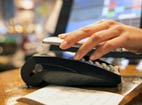
The Path to Mobile Payments 2015

Mobile and digital money technologies already have long histories, but that doesn’t mean that they have been overwhelming successes. Technical challenges, intense business competition and uncertainty on adoption by consumers have all posed challenges for the market.
Vijay Koduri, the senior vice president of marketing for Adyen, acknowledges the market’s progress and issues at Forbes. He referenced a Gallup study to point to what he feels are the remaining obstacles:
Yet, there are still many issues prohibiting mass adoption of digital wallets in the U.S., as highlighted in a recent Gallup study. The study found only 13 percent of U.S. adults have a digital wallet app on their smartphone, with 76 percent of them hardly using it in the last 30 days. When asked what the primary barriers to adoption were, 55 percent cited security concerns, 21 percent mentioned that they just didn’t know enough about it and 14 percent didn’t see any benefit.
However, a study by the Blackhawk Network of more than 1,000 American consumers found that 68 percent of those who used mobile payments last year are doing so more this year. The study counted very common methods of payment, such as credit and debit cards, in the totals. However, it found that 14 percent used smartphones or tablets to make payments, but the ways in which mobile wallets are used varied:
Mobile wallets are now used by 25 percent of smartphone owners, with 64 percent of users carrying debit cards in their mobile wallets, while 58 percent have credit cards and 45 percent have gift cards.
One of the reasons that mobile wallets and electronic payments have not had a smooth ramp up is that there are so many form factors and slightly different utilizations under the overall umbrella. This keeps the category from coalescing in the public’s mind.
The fuzziness of the category continues. Payment Source offers a slide show that illustrates seven ways in which mobile payments are being offered to consumers. They range from Amazon’s Dash, which is a one click payment system for people without mobile equipment, to electronic cards from companies such as Coin, Stratos and Wocket. Clearly, the concept of mobile payments is not, and perhaps can’t be, defined with any specificity.
The 2015 Mobile Money Report, a product of the Mobile Ecosystem Forum, was based on 15,000 mobile media users from 15 nations. The report cited impressive worldwide figures on the broader world of mobile money. It found that 66 percent of mobile media users carried out a transaction last year, and 69 percent used their devices for banking. A quarter said that social media apps were the conduit through which they engaged in mobile commerce and 14 percent shopped while engaging in another activity. It is also significant that a good portion (36 percent) responded that “a lack of trust” prevents them from using a mobile wallet.
The shades of gray between mobile commerce, mobile wallets and mobile banking illustrate the difficulties faced by mobile money. Progress, however, is clearly being made.
Carl Weinschenk covers telecom for IT Business Edge. He writes about wireless technology, disaster recovery/business continuity, cellular services, the Internet of Things, machine-to-machine communications and other emerging technologies and platforms. He also covers net neutrality and related regulatory issues. Weinschenk has written about the phone companies, cable operators and related companies for decades and is senior editor of Broadband Technology Report. He can be reached at cweinsch@optonline.net and via twitter at @DailyMusicBrk.











